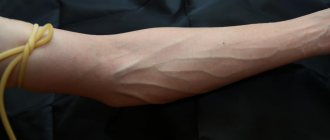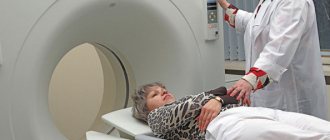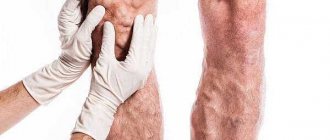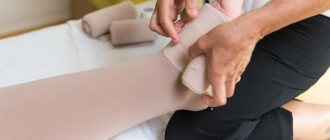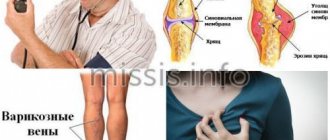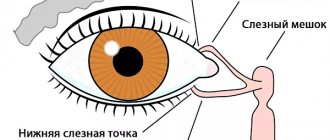Spider veins (webs or telangiectasia) are small visible dilated blood vessels (capillaries) that are located under the surface of the skin. They may be red (fed by cutaneous arteries called arterioles), purple, or blue (fed by reticular veins). The most common locations include the face, upper chest, and neck. Thin red lines that appear to extend across areas of the cheeks and nose indicate a spider web-like appearance (rosacea). The reason for the appearance of spider veins on the body is explained by disturbances in the metabolism of sex hormones in the hepatic system. Treatment of spider veins is a very difficult job for a phlebologist.
Most often, patients present with telangiectasis on the legs. In foreign literature, such spider veins are called spider veins. Spider veins on the legs can become quite noticeable, which for some patients creates a cosmetic problem, but they do not hurt. Because of their small size and superficial location, spider veins rarely lead to venous insufficiency, but many seek to eliminate them to improve aesthetic appearance. It is these signs of varicose veins that attract more attention and therefore are most often the reason for contacting a specialist after unsuccessful “treatment” with apple cider vinegar, folk methods and medications.
Removal of spider veins and visible vessels on the face. (Photocoagulation, photorejuvenation)
Spider veins on the cheeks, nose, red cheeks, purple face - all this is characteristic of the disease rosacea, its first manifestations are often called rosacea. This is a constitutional feature, it does not affect our well-being in any way, but it is of great importance in the perception of the people around us.
There are many options for camouflage, prevention, lifestyle rules, skincare cosmetics that slow down the process, but few techniques can remove dilated blood vessels that have already appeared on the face.
One of the most effective is a hardware procedure using IPL systems, also called photocoagulation or photorejuvenation. This can be done by a cosmetologist in his office. The processing area depends on the area of the process. Of course, what you won’t leave the consultation without is the wise advice of a cosmetologist
CLICK on one photo to view the entire photo gallery
Diagnostic methods
To independently check blood vessels for fragility, it is enough to carry out the following tests:
To check the fragility of blood vessels, you can use a tonometer cuff.
- Pinch. Under the clavicle bone, take the skin with two fingers and twist clockwise. If a hematoma or bruise forms, it means that there is thinning of the vessel wall.
- Drag. Inflate the blood pressure cuff by placing it on your forearm and leave for 10 minutes. After time has passed, remove the tourniquet and if red dots appear on the skin, this indicates damage to the capillaries. The patient needs to see a doctor immediately.
- Hammer. The patient's chest is lightly tapped with a hammer; if bruising occurs, the diagnosis of capillary wall weakness is confirmed.
A laboratory diagnostic method is the examination of blood vessels with a special apparatus - a capillaroscope. It is a microscope with a video camera and a monitor, on which the doctor can detect pathology in the integrity of the wall and subsequently prescribe treatment. The patient is recommended to undergo blood and urine tests to determine the general condition of the body.
Return to contents
Spider veins and redness. Before and after
Spider veins and redness can be of different shapes and locations on the face. Sometimes it’s a star on the nose, and sometimes there’s a sort of painful blush on the cheeks. And the desire to remove such a mark is understandable, because the foundation does not always cover this vascular feature.
Procedures using the IPL system allow you to do this in 1-4 visits. The number of procedures depends on the severity of the process and the individual characteristics of the skin. The interval between procedures is 3-5 weeks; it is better to plan them for the autumn-winter period (spring to April).
Recovery time is 1-3 days, redness and swelling are possible after the procedure. Immediately after, you can apply light makeup.
Cosmetologist's work:
- From 1 to 4 procedures
- Interval 3-5 weeks
- IPL system
- Rehabilitation up to 3 days
Home treatments
If the blood vessels have already burst, then completely removing them at home is unrealistic. However, there are several proven folk remedies that effectively help reduce redness.
Aloe vera
You need to grind the aloe leaf into a paste and rub the affected areas before going to bed. You must first wash your skin with green or black tea. Leftover pastry can be stored in the refrigerator for 2 weeks.
The recipe for an aloe mask is very accessible and simple.
Green tomatoes
You just need to cut the tomatoes into slices and apply them to problem areas. The active ingredients will act within three minutes. Green tomato contains the ideal concentration of essential acids, which have a beneficial effect on reducing redness. This treatment method can be used for no more than 10 days in a row. After using tomatoes, be sure to apply a little nourishing cream.
Parsley leaves
This effective ingredient was used even in ancient Greece. You need to take a handful of parsley leaves and pour 100 ml of boiling water over them. Cover with a lid and leave for half an hour. Then strain the liquid and add 50 ml of milk. Soak a small gauze towel in the liquid and then apply it to your face or other problem area. Leave the compress on for 20 minutes. Perform the procedure every day for a month.
Sage
You need to soak 4 tablespoons of dried sage in 200 ml of boiling water. Cover with a lid and let stand for ten minutes. Drain the water and add 200 ml of milk. Thoroughly cleanse your face with this liquid every day. You can apply a compress for 10 minutes or simply wash your face with sage milk. After the procedure, be sure to rinse the treated area with cold water. You can apply this treatment every day until improvements are seen.
Despite the fact that home methods for getting rid of broken capillaries cannot harm your health, since they are applied externally, you should consult a dermatologist before starting to use them.
Spider veins on the face. Before and after
These are the spider veins that were on the face of a very young patient. There is no point in leaving them, since they themselves will not disappear and over time, on the contrary, they will become larger in size and quantity.
The procedure for removing them is quite short, a few flashes on the IPL system and you can go about your business. Locally there may be redness for 1-3 days, it goes away without a trace and can be covered with foundation from the very first day.
The number of procedures is 1-4, depending on many factors, all this is discussed at the preliminary consultation. It is better to carry out the procedure in a non-sunny period and not plan it a few days before your vacation.
Cosmetologist's work:
- From 1 to 4 procedures
- Short procedures
- IPL system
- Rehabilitation up to 3 days
Risk factors
Causes of vascular fragility:
- Weakness of the walls of veins and capillaries, disruption of their permeability.
- Vessels in the legs burst due to prolonged stress on them.
- Common causes of ruptured blood vessels are pregnancy, childbirth, the use of oral contraception, abortion, ovarian cysts, fibroids, menopause and other phenomena that cause hormonal imbalance.
- Endocrine disorders in women.
- Poor nutrition.
- Physical inactivity.
- Bad habits.
- Skin damage caused by chemical peels, regular visits to the solarium, frostbite, burns.
- If a vein in the leg bursts, this is a sign of the initial stage of varicose veins.
- Fragile blood vessels can be a consequence of heavy training (the result of changes in blood pressure).
- Infections and viruses weaken the walls of blood vessels. After the underlying disease is treated, the burst capillaries disappear on their own.
- Systemic pathologies can contribute to the fragility of blood vessels in the fingers and toes: diabetes mellitus, obesity, coronary artery disease, angina pectoris, atherosclerosis, hypertension.
- Allergies can also cause the problem. So, when blood vessels on the hands burst, this may be a reaction to household chemicals.
- A lack of vitamins P and C in the body can cause increased fragility of the walls of capillaries and veins. In this case, the following symptoms occur: chills, the skin on the fingers and toes may turn blue. Hematomas due to deficiency of ascorbic acid and rutin form in autumn and winter.
Symptomatic treatment helps eliminate vascular fragility (it is carried out in a hospital and at home). True, when blood vessels burst in the hands due to a systemic disease, for example, hormonal imbalance, they will be damaged again.
The risk group includes people with sedentary jobs (drivers, teachers, office employees). Representatives of these professions are recommended to do a warm-up at least once every two hours - walk around the room, perform rotational movements with their arms, do several bends back, forward and to the sides.
Wine stains on the face. Before and after
This is not the final result
Port-wine stains on the face and other open areas of the skin are very disturbing to owners. Some people get used to their presence over the years, while others come and remove them. Removing port-wine stains is not an easy task, but it is completely within the capabilities of both the patient and the doctor. This photo shows the result after 3 procedures and this is not the final result .
In addition to photo flashes on a device with an IPL system, special medications are prescribed for home care. The procedures are carried out at intervals of 3-5 weeks. Rehabilitation - redness and slight swelling of the treated area for 1 to 3 days.
Cosmetologist's work:
- Procedure interval 3-5 weeks
- Rehabilitation up to 3 days
- IPL system
- Not final result
Main causes of pathology
The capillary network in its structure has arterioles, precapillaries and venules. Capillaries can burst on the body for the following reasons:
- weakness of the capillary wall;
- excessive load on the lower limbs;
- thrombocytopenia;
- hypothermia;
- skin hypersensitivity;
- excess weight;
- cirrhosis of the liver;
- injury;
- diseases of the cardiovascular system;
- vegetative-vascular dystonia;
- exposure to chemicals;
- disturbances in the functioning of the endocrine gland.
Most often, the cause is the individual predisposition of the body, as well as thinning of the capillary wall, due to which it cannot withstand pressure. People suffering from hypertension should regularly examine their body for bleeding on the skin. Bursted capillaries indicate a surge in pressure that went unnoticed. In such patients, the vascular bed has pathological fragility, which can react when the weather changes. Women during pregnancy, childbirth, abortion, hormonal therapy complain that capillaries burst. Basically, when hormonal levels change, such a pathology does not pose a great danger to life and health, but can cause discomfort.
A person with a history of heart attack, stroke or vegetative-vascular dystonia is more prone to fragility of the vascular wall than others.
Return to contents
Vessels on the face, redness and swelling. Before and after
The procedure is not very pleasant, but tolerable, and most importantly, quite fast. Rehabilitation takes an average of 24 hours; in rare cases, there may be redness and swelling for up to 3-5 days. Therefore, if you have not undergone a similar procedure before, it is better to schedule it before a couple of days off. Usually 3-4 procedures are required with an interval of 3-5 weeks, the effect is often visible after 1-2 procedures.
Signs and diagnosis
To establish the degree of vascular damage, the following techniques are used:
- Treatment of cerebral vessels: folk remedies, traditional medicine
- Pinch method: The fold of skin in the chest area should be pinched between the middle and index fingers. Accidental damage is excluded in this area, and pressure on the skin does not cause pain. If after the manipulations a hemorrhagic spot has formed on the tested area, the fragility of the blood vessels is significant.
- Tap the skin in the chest area with a hammer. If hematomas appear after this, the walls of the vessels are weakened.
- Tourniquet method. The middle part of the shoulder is rewound with a tourniquet so that the outflow of venous blood is stopped and arterial blood is not disturbed. If, after removing the tourniquet, petechiae have formed in the area being examined, the degree of vascular fragility is high, and the patient requires medication therapy.
When diagnosing problems with blood vessels, you need to pay attention to the following symptoms:
- Dizziness.
- The appearance of “stars” or black dots before the eyes with a sudden change in body position.
- Even minor injuries result in broken capillaries on the fingers, forearms, ankles, etc.
- A network of blood vessels is visible through the skin.
- Feeling of chills even in a warm room.
Vessels (rosacea). Before and after
Red cheeks, red face, spider veins, rosacea, rosacea
Red cheeks, red face, spider veins, rosacea, rosacea - there are many names, but the essence is the same. Expansion of the superficial vascular network is a genetic predisposition that is enhanced by many external factors (air temperature, nutrition, stress).
Such redness on the face today can only be removed using IPL, broadband intense light, this is a hardware technique. 3-4 procedures at intervals of a month, and excellent results.
Share this post
Prevention
Unfortunately, if a vessel under the eye bursts, you should not expect it to heal or resolve on its own.
It is useless to treat the damaged capillary itself, but you can prevent the occurrence of new foci of subcutaneous bleeding by adhering to the following rules:
- if burst vessels have already been noticed, then it is necessary to avoid for several months all procedures that involve the use of vacuum, rollers, and powerful lasers;
- If blood vessels on the legs burst, then you need to stop using rough scrubs, massages, and wraps. But the use of fruit acids is not prohibited.
- Do not rub or pull damaged skin;
- wash your body only with warm water, not hot or cold;
- avoid visiting the sauna, solarium;
- protect the skin from frost with fatty, oily creams;
- adhere to a balanced diet, paying special attention to the presence of vitamin C;
- no smoking;
- keep alcohol consumption to a minimum. In particular, red wine provokes rupture of capillaries.
Why do blood vessels in the eyes often burst due to overwork?
Ophthalmologists are sounding the alarm that there are more and more people with poor vision in the world. At the same time, visual pathologies become “younger.” Refractive defects are increasingly being diagnosed in minors, including very young children (preschoolers and primary school students). This is due to the use of electronic devices - phones, computers, tablets. Because of them, a person’s eyes are in constant tension. At the same time, few people do special gymnastics to relax the eye muscles. The vessels cannot withstand the stress and burst. Lack of visual hygiene can subsequently lead to visual deterioration.
Why do blood vessels burst in the eyes? Causes of the symptom
The human eyes are penetrated by many tiny vessels and capillaries. They provide the tissues of the eyeball with oxygen, thanks to which the full functioning of the visual organs is possible. Red spots and mesh on the tunica albuginea indicate hemorrhages resulting from thinning and rupture of the walls of blood vessels.
There are several groups of factors that lead to rupture of vessel walls:
eye fatigue; physical exercise; physical impact on the eyeball; weak blood vessels, which is a sign of disease.
Let's look at all these factors in more detail.
Signs of development of vascular disorders
Facial redness
This is the initial stage of vascular disorders, which is called erythrosis. Occurs under certain circumstances and provoking factors. Sometimes it appears for no reason. The wings of the nose, cheeks and chin are most prone to the onset of the disease. The sensitivity of the skin in these areas increases and it becomes red. A sick person complains of fever, itching, and tingling. This state can last from a couple of minutes to two hours. This skin pathology on the face can spread to the neck.
Constant redness
In problem areas there is already a constant state of redness of the skin. Spider veins and stars begin to appear, as well as pigmentation.
This condition is similar to a flush or sunburn that does not go away.
Skin changes
The skin becomes thinner, dries out, and has a grayish color. Inflammation begins in problem areas, sometimes they become covered with a rash. The disease progresses gradually and its third stage without treatment occurs 20-30 years from the onset of the pathology.
Cuperosis as a manifestation of diseases of internal organs.
The most common diseases that cause damage to the vascular wall:
- arterial hypertension, acute crisis or chronic malignant course, when systolic blood pressure is above 160 mmHg and cannot be corrected.
- diabetes mellitus, in which the level of glycated hemoglobin in the blood increases, which leads to disruption of oxygen metabolism in the vascular wall and causes tissue hypoxia. Subsequently, microangiopathy develops, leading to trophic disorders.
- vascular symptoms can be a warning sign indicating the presence of liver disease, an inflammatory process of an infectious or viral nature.
- autoimmune diseases, such as systemic lupus erythematosus and scleroderma, are also manifested by damage to the capillary network, which can serve as an early diagnostic symptom.
- hormonal disorders of various origins, ranging from dysfunction of sex hormones to disorders caused by brain tumors.
